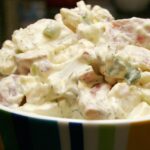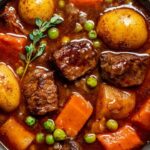Created in the ’70s, this dish is an explosion of veggie goodness
Prep: 15 mins
Cook: 25 mins
Total: 40 mins
Servings: 4 (serving size: 1 1/2 cups)
Pasta primavera is a classic pasta dish, but it’s not Italian. That’s right. It was created by chefs at Le Cirque restaurant in New York City in the late 1970s.
What is Pasta Primavera?
The original pasta primavera was made with spaghetti, a riot of colorful vegetables, and a cream sauce and was, for a time, a cultural phenomenon. The dish feels a bit out of style now with its clown car of random produce jumbled together, but somehow the flavors, colors, and textures of this dish just work.
Our recipe swaps spaghetti for penne, as penne can be incorporated with the vegetables more easily than spaghetti, which wants to clump and push all the vegetables to the bottom of the skillet. We also skip the original recipe’s laborious method of blanching each vegetable individually for a single-skillet method that produces fewer dishes and preserves the fresh flavors of the vegetables.
Why is it Called Pasta Primavera?
Primavera means spring in Italian, presumably referring to the many vegetables found in this dish. Originally the name made this dish a darling of the “seasonal cooking” trend of the 1980s, though by today’s standards the tomatoes, zucchini, and basil would have no place in a seasonal spring dish. Part of the key to enjoying this dish is not thinking too hard about it.
What is Pasta Primavera Sauce Made Of?
The primavera sauce is an extremely simple one made with heavy cream flavored with garlic, lemon zest, and lemon juice and bolstered with pasta cooking water. Though it is a cream-based sauce it manages to be light, just clinging to the pasta and vegetables and not turning them stodgy.
Perhaps the nicest thing about this pasta dish is that it is incredibly versatile. Use different vegetables, like sweet peppers, eggplant, cauliflower, or even a handful of greens. Substitute different pasta shapes like farfalle or you can even try the classic spaghetti. While the original dish is vegetarian, you can add shredded chicken or cooked shrimp for more protein.
Tips for Making Pasta Primavera
- The sauce will thicken—You may think the sauce is a little thin, but once you pull the pan off the heat and start dishing up the pasta, the sauce will thicken to the perfect consistency. Don’t be tempted to over-thicken the sauce by reducing it as it will result in a gloppy sauce.
- Salt your pasta water—Make your pasta water as salty as the sea. Never tasted the sea before? It’s hella salty! So salty you wouldn’t even want to drink a spoonful. You want this because the pasta is completely unseasoned and you are trying to infuse it with some salt so it’s not flavorless.
- Avoid oversalting the sauce—Because you’re going to use some of the (hella salty) pasta water in your creamy pasta sauce, go light on the salt until the very end, at which point you can add more salt if needed. Though you probably won’t if you follow the recipe.
«I appreciate that this is more of cream sauce rather than a heavy, cheesy sauce. The vegetables are enriched with the heavy cream but not overwhelmed by it. You can really identify the savory garlic and cheese, as well as the sweetness from the tomatoes, and heat from the crushed red pepper in the sauce — it’s got it all.»—Spruce Eats Test Kitchen
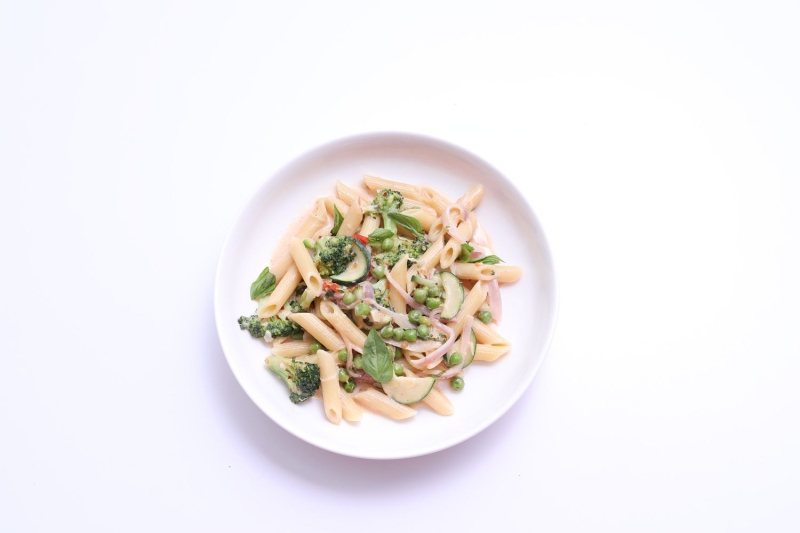
A Note From Our Recipe Tester
Ingredients
-
8 ounces uncooked penne rigate pasta
-
3 tablespoons olive oil
-
2 cups broccoli florets, cut into bite-size pieces (from 1 small head)
-
1 cup sliced red onion (from 1 medium onion)
-
1 small zucchini, sliced into half moons (about 1 1/3 cups)
-
1/4 teaspoon fine salt
-
1/4 teaspoon ground black pepper
-
1/4 teaspoon crushed red pepper
-
2 tablespoons unsalted butter
-
4 garlic cloves, finely chopped
-
1 cup cherry tomatoes, halved
-
1 tablespoon finely chopped fresh basil, plus small leaves for garnish
-
1/2 cup heavy whipping cream
-
1/2 cup (2 ounces) finely grated parmesan cheese
-
1/2 cup frozen sweet peas
-
1 teaspoon grated lemon zest
-
1 1/2 tablespoons fresh lemon juice (from 1 lemon)
Steps to Make It
-
Gather the ingredients.
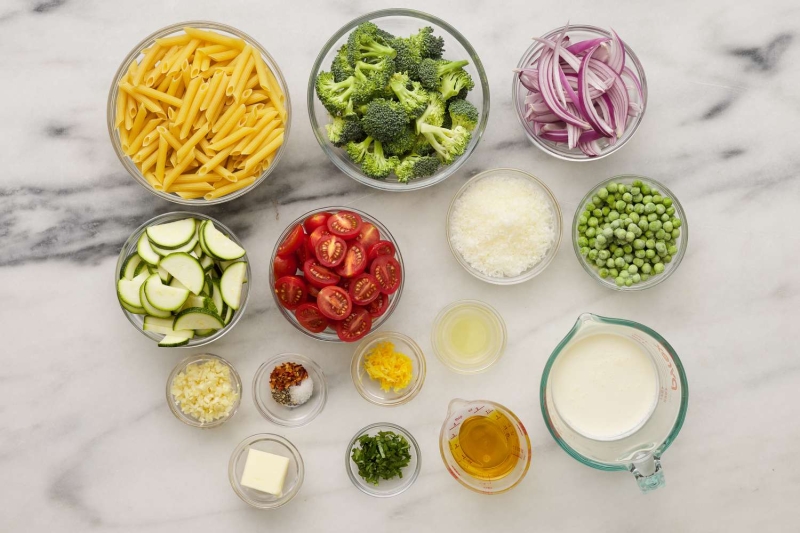
-
Bring a large pot of well-salted water to a boil over high heat. Cook 8 ounces penne according to package instructions for al dente.
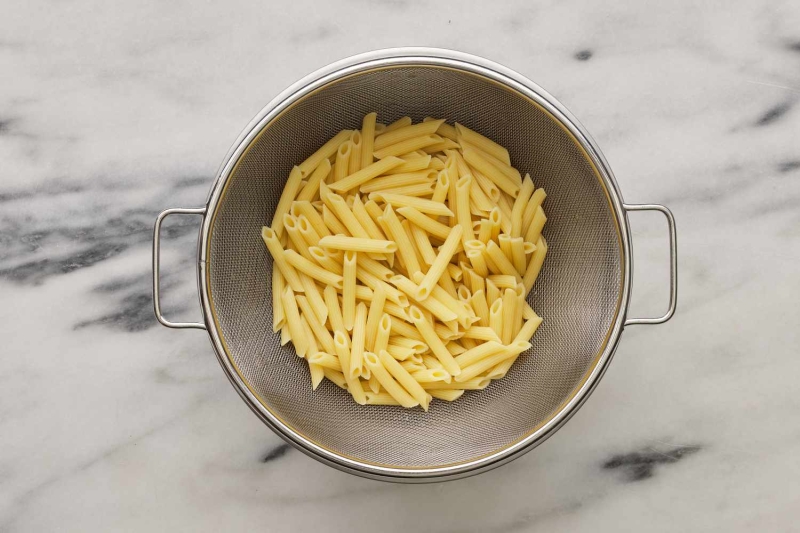
-
Drain pasta, reserving 1 cup of cooking water.
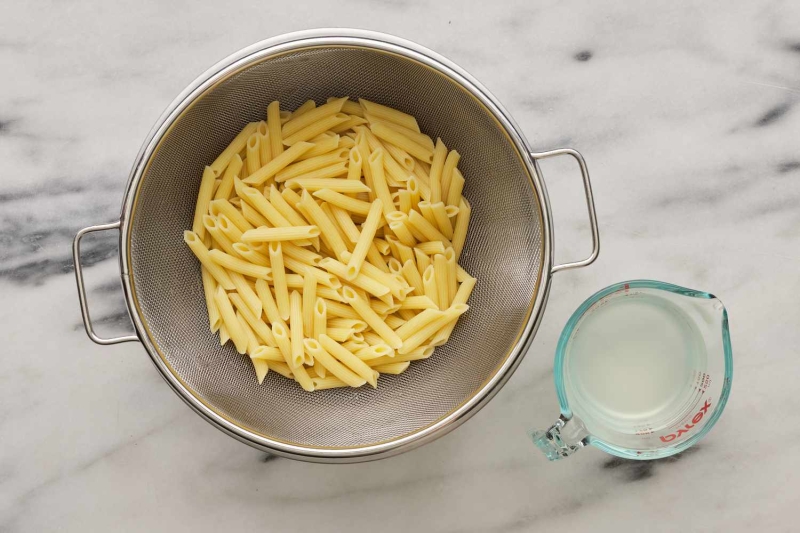
-
While the pasta is cooking, heat 3 tablespoons olive oil in a large skillet over medium-high. Add 2 cups broccoli florets, cut into bite-size pieces and cook, stirring occasionally, until bright green, about 2 minutes.
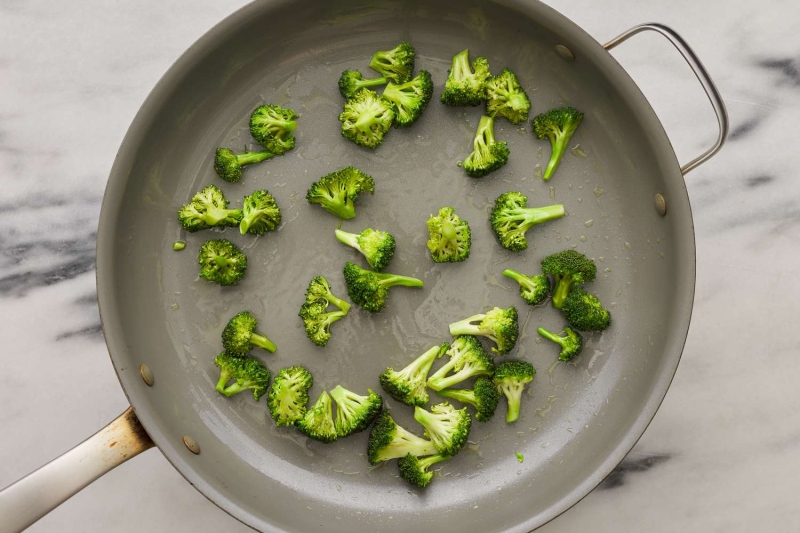
-
Add 1 cup sliced red onion, 1 small zucchini, sliced into half moons, 1/4 teaspoon fine salt, 1/4 teaspoon black pepper, and 1/4 teaspoon crushed red pepper. Cook, stirring occasionally, until the vegetables are tender-crisp, about 4 minutes. Transfer the vegetables to a medium bowl and set aside.
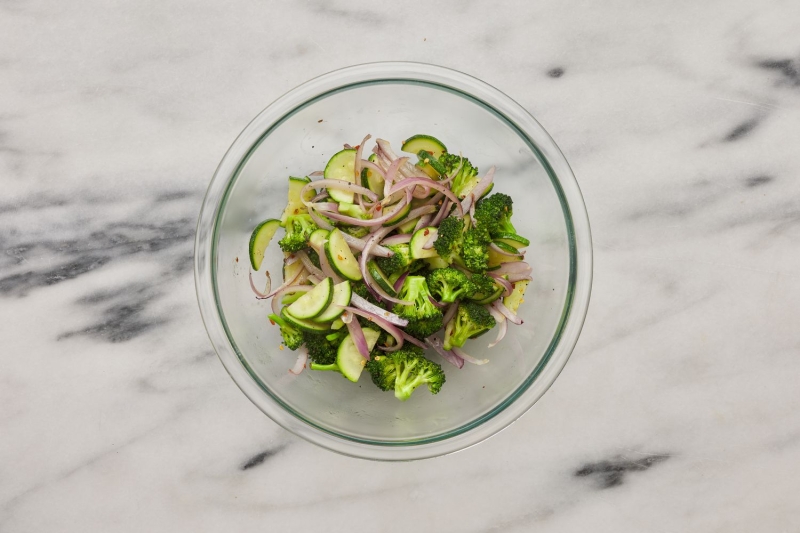
-
Reduce the heat to medium and add 2 tablespoons unsalted butter to the skillet. Once melted, stir in 4 garlic cloves, finely chopped and cook, stirring constantly, until fragrant, about 30 seconds.
Stir in 1 cup cherry tomatoes, halved and 1 tablespoon finely chopped basil, then pour in 1/2 cup heavy cream and 1/2 cup of the reserved pasta cooking water. Bring to a simmer over medium, then gradually stir in 1/2 cup (2 ounces) finely grated parmesan until the cheese is melted and the sauce is smooth, about 1 minute.
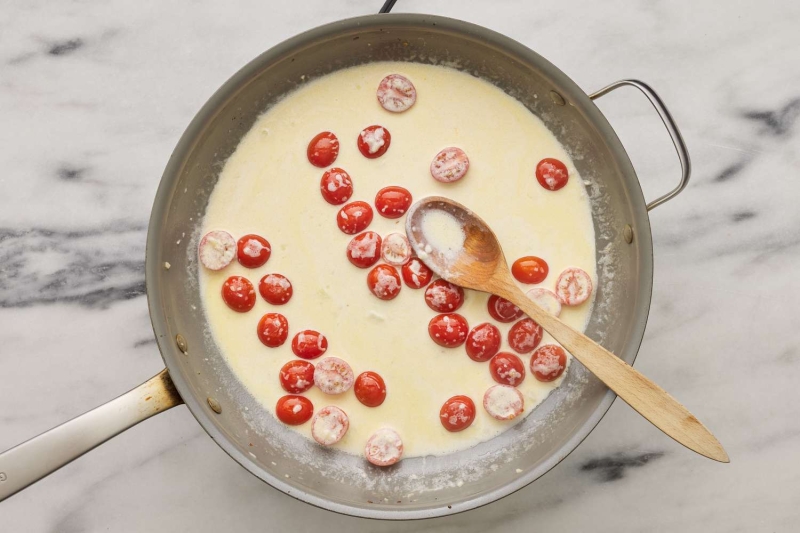
-
Add 1/2 cup frozen peas, 1 teaspoon grated lemon zest, and 1 1/2 tablespoons fresh lemon juice. Let simmer until the sauce is slightly thickened and creamy, about 2 minutes.
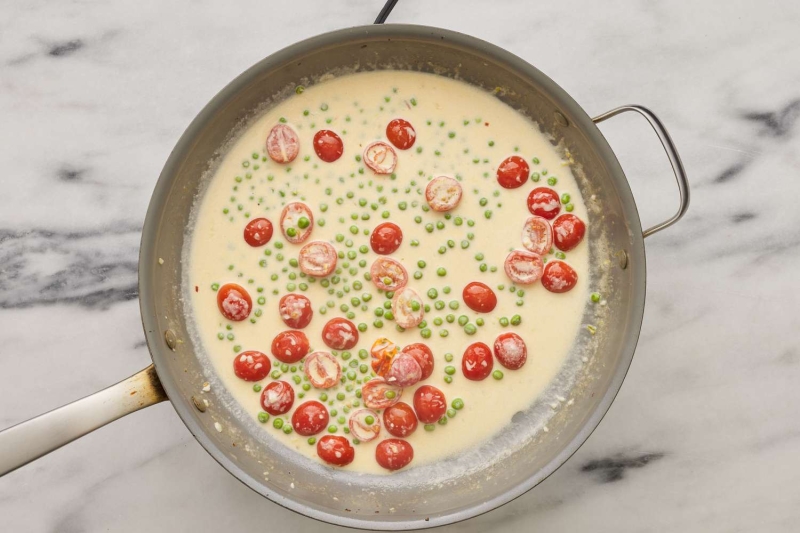
-
Return the cooked vegetables to the skillet and stir in the cooked pasta. Cook over medium heat, stirring constantly, until the pasta is evenly coated in sauce, about 2 minutes, adding remaining pasta water as needed to reach the desired consistency. Divide the pasta evenly between 4 bowls. Garnish with fresh basil leaves.
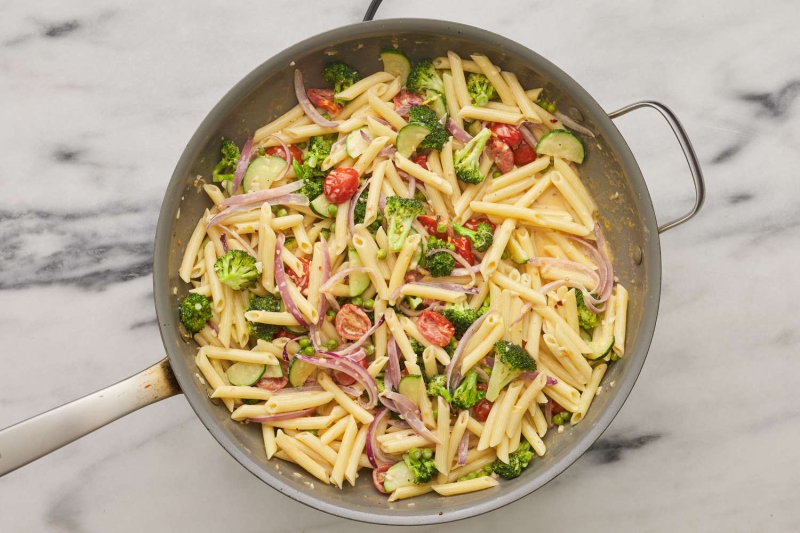
How to Serve
Refrigerate leftover pasta primavera in an airtight container for up to 3 days. Reheat gently in a nonstick skillet, adding a little water to loosen the pasta and sauce.
Recipe Variations
- Use your favorite veggies—This is a great recipe for cleaning out the crisper. Swap cauliflower, sweet peppers, snap peas, or asparagus for some of the vegetables in the recipe.
- Use a different pasta—Substitute bowties or even angel hair pasta for the penne.
- Try crème fraîche—Use 1/2 cup crème fraîche instead of heavy cream for the sauce.
- Vegan pasta primavera—Substitute cashew cream for the heavy cream (if you need a guide, follow the one in this vegan vodka sauce recipe), olive oil or vegan butter for the butter, and omit the parmesan or use a vegan parmesan substitute.
| Nutrition Facts | |
|---|---|
| Servings: 4 | |
| Amount per serving | |
| Calories | 483 |
| % Daily Value* | |
| Total Fat 32g | 41% |
| Saturated Fat 14g | 71% |
| Cholesterol 61mg | 20% |
| Sodium 438mg | 19% |
| Total Carbohydrate 40g | 14% |
| Dietary Fiber 7g | 24% |
| Total Sugars 8g | |
| Protein 13g | |
| Vitamin C 73mg | 366% |
| Calcium 220mg | 17% |
| Iron 2mg | 13% |
| Potassium 754mg | 16% |
| *The % Daily Value (DV) tells you how much a nutrient in a food serving contributes to a daily diet. 2,000 calories a day is used for general nutrition advice. | |

